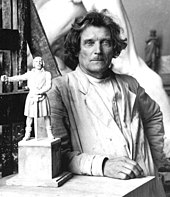Carl Eldh
Carl Eldh (born May 10, 1873 in Dannemora , † January 26, 1954 in Stockholm ) was a Swedish sculptor who was mainly active in the first half of the 20th century.
life and work
Eldh came from a simple family background from the small mining town of Dannemora in Uppland , Sweden . His father was a blacksmith, which certainly influenced Carl Eldh's career ideas. 1897–1904 he studied sculpture at the Académie Colarossi in Paris , where he was greatly inspired by the French sculptor Auguste Rodin . His early works are characterized by soft, idealistic forms, such as B. Jugend ( Ungdom ) from 1911. Later, however, his style developed into powerful realism , as in the Rodin-inspired Strindberg Monumentet in Tegnérlunden in Stockholm from 1916. Carl Eldh also became known through many of his portrait busts of contemporary cultural personalities, especially August Strindberg repeatedly depicted, both with and without clothing. Eldt also worked as a medalist:
- Cast bronze medal 1920, 117 mm, on the painter Anders Zorn (1860–1920)
Eldh was, along with Christian Eriksson and Carl Milles, the most frequently commissioned Swedish sculptor during the first half of the 20th century. Eldh often worked with well-known Swedish architects who liked to employ him as a sculptor, including Ivar Tengbom , Erik Lallerstedt and Ragnar Östberg . In 1923, Carl Eldh was commissioned by Ragnar Östberg, the architect of Stockholms stadshus , to decorate the Stadshuspark with sculptures. This is how the trilogy "Author" Författaren ( August Strindberg ), "poet" Poeten ( Gustav Fröding ) and "painter" Målaren ( Ernst Josephson ) came about, which initially provoked strong protests because of their nudity. However, after the death of the cultural personalities depicted, the criticism quickly subsided. Carl Eldh's greatest work is the Branting monument on Norra Bantorget in Stockholm, initially made in plaster from 1930–1942, the bronze was only in place in 1952.
In 1918 Eldh had his own studio built in Bellevuepark in northern Stockholm. The architect was his good friend Ragnar Östberg. Carl Eldh's studio is now a museum, Carl Eldh's Ateljémuseum . The two studio rooms are filled from floor to ceiling with sketches , sculptures , tools and other personal items. A visit there not only gives an insight into the creative work of a sculptor from the beginning of the 20th century, but also enables the direct study of Carl Eldh's era.
Literature in Swedish
- Åsa Cavalli-Björkman, Petra Gröminger: Carl Eldhs Ateljémuseum. ISBN 91-631-7296-8 .
- Karl Asplund : Carl Eldh. Stockholm 1943.
- Konstnärsförbundets årshften. 1904.
Web links
- More about Carl Eldh's Atelier Museum (English)
- More about Carl Eldh at "SIC" (Swedish)
| personal data | |
|---|---|
| SURNAME | Eldh, Carl |
| BRIEF DESCRIPTION | Swedish sculptor |
| DATE OF BIRTH | May 10, 1873 |
| PLACE OF BIRTH | Dannemora (Östhammar) |
| DATE OF DEATH | January 26, 1954 |
| Place of death | Stockholm |


